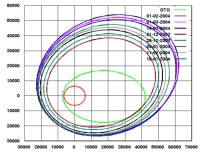No. 20 - Eclipse Period Over
All the autonomous functions on board designed to monitor the eclipse phase and predict the power conditions have also been working very accurately. Now SMART-1 can re-start its journey to the Moon. The thrusting phase has restarted to increase further the orbit apogee. The new strategy involves thrusting around perigee at every revolution for about 8 to 10 hours for the next month. More details on this new strategy will be included in the next report.
Orbital/Trajectory information
The ESOC specialists periodically compute the osculating orbital elements. These elements define the so-called "osculating orbit" which would be travelled by the spacecraft if at that instant all perturbations, including EP thrust, would cease. Therefore, it is an image of the situation at that epoch. In reality, the path travelled by the spacecraft is a continuous spiral leading from one orbit to another. The most recent osculating elements are as follows:
|
EPOCH (UTC) 2004/03/14 23:11:07.1 Elements WRT Earth (J2000) |
|
| Pericentre Distance (km) |
20 679.628282 |
| Apocentre Distance (km) |
68 788.909158 |
| Semi Major Axis (km) |
44 734.268720 |
| Eccentricity |
0.537723 |
| Inclination (deg) |
6.998998 |
| Asc. Node (deg) |
148.668864 |
| Arg. of Pericentre (deg) |
215.031401 |
| True Anomaly (deg) |
180.023840 |
| Osc. Orbital Period (h) |
26.155860 |
 |
- Semi-major axis of the orbit increased by more than 20 000 km
- Perigee altitude from 656 km to 14 305 km
- Apogee altitude from 35 844 km to 62 410 km
- Orbital period from 10 hours 41 minutes to 26 hours and 10 minutes
Contact Points
Giuseppe Racca
SMART-1 Project Manager
ESA/ESTEC - SCI-PD
Keplerlaan 1- 2200 AG Noordwijk, The Netherlands
E-mail: Giuseppe.Racca esa.int
esa.int
Bernard H. Foing
SMART-1 Project Scientist
ESA/ESTEC - SCI-SR
Keplerlaan 1- 2200 AG Noordwijk, The Netherlands
E-mail: Bernard.Foing esa.int
esa.int

